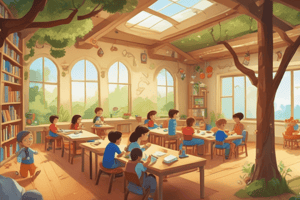Podcast
Questions and Answers
What is a key component of cognitive development in a preschool environment?
What is a key component of cognitive development in a preschool environment?
- Physical activities and outdoor play
- Exploration and problem-solving (correct)
- Interaction with peers and teachers
- Emotional regulation and guidance
How does a well-structured preschool environment support physical development?
How does a well-structured preschool environment support physical development?
- By providing emotional support and guidance
- By introducing basic math and language concepts
- By incorporating physical activities and promoting health and safety practices (correct)
- Through interaction with peers and teachers
What is a key aspect of a preschool environment that prepares children for formal schooling?
What is a key aspect of a preschool environment that prepares children for formal schooling?
- Emotional regulation and guidance
- Introduction to basic math and language concepts (correct)
- Social-emotional development
- Cultural and ethical development
Why is it important for educators to get down to a child's level when arranging the classroom environment?
Why is it important for educators to get down to a child's level when arranging the classroom environment?
What is a benefit of incorporating diverse elements in the classroom environment?
What is a benefit of incorporating diverse elements in the classroom environment?
Why is it important to position areas for quiet activities away from louder ones?
Why is it important to position areas for quiet activities away from louder ones?
What is the purpose of having visible instructions or cues in each Center?
What is the purpose of having visible instructions or cues in each Center?
Why should educators gather feedback from children and other educators?
Why should educators gather feedback from children and other educators?
What is the result of following guidelines for creating a positive learning environment?
What is the result of following guidelines for creating a positive learning environment?
What should educators balance when choosing classroom materials and decorations?
What should educators balance when choosing classroom materials and decorations?
Flashcards are hidden until you start studying
Study Notes
Importance of a Well-Structured Learning Environment in Early Childhood
- A well-structured learning environment is crucial for the holistic development of a child in early childhood preschool.
- It contributes to cognitive development by providing opportunities for exploration, questioning, and problem-solving.
Cognitive Development
- A thoughtfully designed learning environment encourages children to learn new skills and concepts through exploration and play.
- It enhances their natural curiosity, a key component of cognitive development.
Social-Emotional Development
- Interaction with peers and teachers in a structured setting helps children develop important social skills such as sharing, cooperation, and empathy.
- Positive interactions and accomplishments in a preschool environment can boost a child's confidence and self-esteem.
Physical Development
- Physical activities incorporated into the learning environment support the development of fine motor skills (e.g., using crayons and scissors) and gross motor skills (e.g., climbing and jumping).
- A safe and health-conscious environment teaches children about the importance of health and safety practices.
Language Development
- Regular interaction with teachers and peers in preschool enhances verbal skills, vocabulary, and overall communication abilities.
- Exposure to early childhood books, storytelling, and writing activities supports literacy development.
Emotional Regulation
- Teachers in a preschool environment provide emotional support and guidance, helping children understand and regulate their emotions.
- Structured activities and guided interaction help children manage frustrations and challenges.
Preparation for Formal Schooling
- Early exposure to structured learning environments can make the transition to formal schooling easier for children.
- Basic math, language, science, and arts concepts introduced in preschool lay the groundwork for future academic learning.
Cultural and Ethical Development
- A preschool incorporating elements from various cultures and backgrounds promotes understanding and acceptance among young children.
- It introduces basic concepts of right and wrong, fairness, and justice, which are important in ethical development.
Creating an Effective and Nurturing Classroom Environment
- A thoughtful approach to classroom design considers the child's viewpoint and experience.
- Key strategies for optimizing the classroom environment include:
- Physically getting down to a child's level to assess their view.
- Using a space to clearly define pathways and discourage unsafe behaviors.
- Strategic placement of furniture and materials to ensure effective monitoring and quick intervention.
- Incorporation of diverse elements, such as cultural items and decorations, to reflect the children's backgrounds.
- Designing classroom spaces that can be easily adjusted for different activities and group sizes.
- Positioning areas for quiet activities away from louder ones to manage noise levels and minimize disruptions.
- Choosing classroom materials and decorations that are visually stimulating but not overwhelming.
- Providing visible instructions or cues to guide children in engaging with materials.
- Regularly gathering feedback from children and other educators to continually improve the learning environment.
Studying That Suits You
Use AI to generate personalized quizzes and flashcards to suit your learning preferences.




